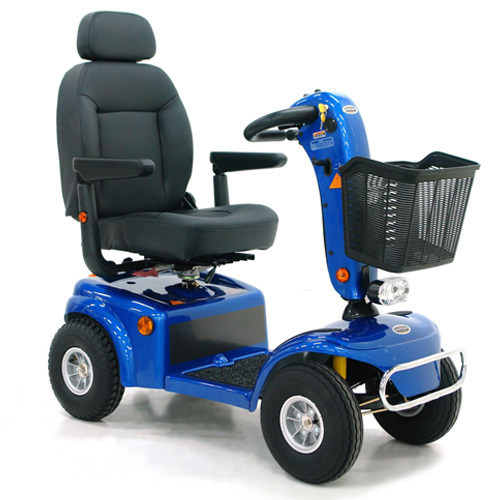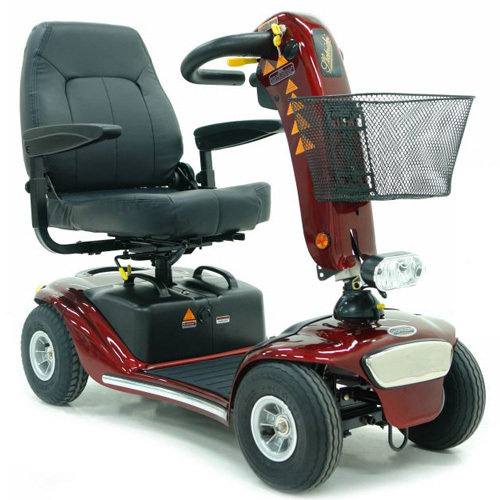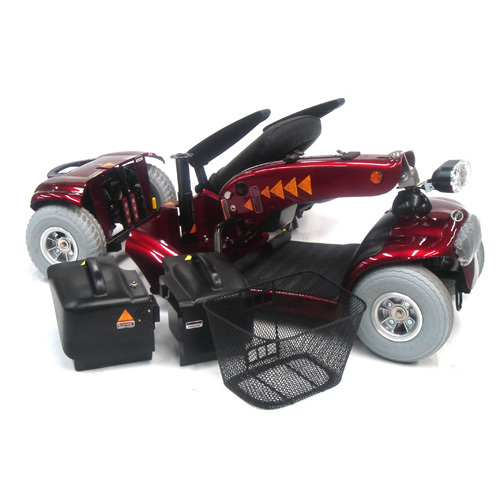Mobility Scooter: What You Need to Know
Mobility Scooter: What You Need to Know
Navigating everyday tasks can be a challenge when mobility is limited. But in this modern age, we’re fortunate to have devices that assist and support independence. One such device is the mobility scooter, a boon to many who face mobility restrictions.
Mobility scooters have opened a new world of possibilities – they’re not just about getting from A to B, they’re about maintaining independence, increasing comfort, and enhancing quality of life. With such a transformative piece of technology comes a wealth of considerations: how does one choose the right one? Do you need any special licence to operate it? What about maintenance and costs?
Whether you are considering options or ready to invest in a mobility scooter, this blog will guide you through what you need to know, with insights and tips to help you make an informed decision.

What is a Mobility Scooter
A mobility scooter is a battery-powered, motorised personal transport device designed for people with limited mobility. They are engineered to provide supplementary assistance in manoeuvring around both indoor and outdoor spaces, making it easier for those with physical restrictions and mobility challenges to maintain independence.
Design and Structure
Mobility scooters typically consist of a comfortable, ergonomically designed seat mounted on a flat and stable platform. They have handlebars or steering tillers in the front, allowing the user to steer and control the scooter easily. The device is powered by a rechargeable battery and runs at a safe speed, ensuring that users feel both stable and secure while in motion. Mobility scooters are also equipped with brakes, lights, and turn indicators for added safety.
Functionality
The primary purpose of a mobility scooter is to enable users with mobility issues to travel conveniently both inside and outside their homes. These devices are available in different configurations, offering different top speeds, travel ranges, and manoeuvrability to accommodate various needs. Mobility scooters can be used on sidewalks, pedestrian areas, and sometimes even on roads.
Who Can Use a Mobility Scooter
Mobility scooters are suitable for individuals with various levels of mobility challenges, such as those with limited strength and stamina or those who have trouble walking or standing for extended periods. They are also excellent options for individuals with conditions like arthritis, multiple sclerosis, stroke recovery, or any ailment that hinders mobility. However, before deciding to use a mobility scooter, it is essential to consult with a healthcare professional to determine if it is the right choice based on your unique needs and abilities.

What is the Difference between a Mobility Scooter and a Scooter

While mobility scooters and scooters may initially seem similar, they are quite different in both design and purpose.
Mobility Scooter
Purpose
Mobility scooters are designed to assist individuals with limited mobility in their daily life. They enhance independence and enable users to travel both indoors and outdoors with ease, tackling mobility challenges due to ageing, injury, or health conditions.
Design
Mobility scooters typically have a comfortable seat, mounted on a stable platform, with handlebars or a steering tiller to guide movement. They prioritise user comfort and are built with added safety features like brakes, lights, and turn indicators.
Speed
Since they are designed with safety and accessibility in mind, mobility scooters tend to have a lower top speed, usually ranging from 6.4 to 19.3 km/h (4 to 12 mph) depending on the model. They are optimised for comfort and safety, not high-speed travel.
Driving Controls
Mobility scooters are operated using simple and accessible control, usually situated on the handlebars. They are suitable for users with limited dexterity or hand strength.
Legality
Mobility scooters are legally classified as mobility aids and have specific rules and regulations governing their use, such as restrictions on road use, speed limits, and pavement accessibility. In many regions, mobility scooters do not require a driver’s licence, and they are subject to specific regulations regarding their use. In Australia, wheelchairs and scooters should be speed limited to 10 km/h on level ground.
Scooters
Purpose
Traditional scooters (like kick scooters and electric scooters) are designed primarily for recreation, commuting, or short-distance travel. They are mostly used by people without mobility issues, serving as a convenient means of personal transportation.
Design
Scooters usually consist of a platform on two or three wheels with a handle for steering. They have a more minimalistic build compared to mobility scooters and often lack the same level of added comfort, stability, and safety features.
Speed
Traditional scooters, especially electric scooters, tend to be faster than mobility scooters, with some reaching speeds up to 28 mph or higher depending on the model.
Driving Controls
Kick scooters are user-propelled, while electric scooters have throttle controls and occasionally a handlebar-mounted display with speed and battery status.
Legality
Traditional scooters, especially those with internal combustion engines, typically require a valid driver’s licence and must adhere to standard road traffic regulations.
What are the Disadvantages of Mobility Scooters
While mobility scooters bring many benefits for people with limited mobility, like any other device, they are not without their downsides. It’s crucial to weigh the advantages against the potential disadvantages to make an informed decision that suits your needs best.

Here are the disadvantages of mobility scooters:
1. Limited Mobility in Rough Terrain
One potential downside to mobility scooters is that they may struggle with rough or uneven terrain, especially the smaller, more compact models. The scooter’s ability largely depends on its design and wheel size, and while heavy-duty models often fare better in this regard, navigating over bumpy roads or steep slopes can still pose a challenge.
2. Require Adequate Storage Space
Mobility scooters require sufficient space for storage and safekeeping, which can be a disadvantage if you have limited room at your home or in your vehicle. Moreover, some models can be heavy and difficult to transport without the aid of specific vehicle modifications, such as a lift or ramp.
3. Limited Battery Life
While mobility scooters are powered by batteries meant to last through several hours of use, they do require regular charging. If the battery runs out mid-journey, it could leave the user stranded and dependent on external assistance. Therefore, proper battery management and planning travel routes accordingly are essential.
4. Initial Cost and Maintenance
The initial cost of investing in a mobility scooter can be high compared to other mobility aids like canes or walkers. Furthermore, potential future costs, like battery replacements or repairs due to wear and tear, can add to overall expenditure. These costs, however, often prove to be worth the resulting improvement in quality of life and independence.
5. Accessibility Concerns
Another potential disadvantage of mobility scooters is the accessibility issue in certain public places or buildings. It might be challenging to navigate around tight corners, narrow aisles, or crowded spaces, meaning that planning and consideration are necessary before visiting new environments.
Remember, the goal is to find a mobility solution tailored to your unique needs and circumstances. Therefore, consider these aspects carefully and consult with a mobility expert or health care provider before purchasing your mobility sooter.
What Makes a Good Mobility Scooter to Buy

With so many mobility scooter options available, determining which one is the perfect fit for your unique needs can be a challenge. These factors will guide you in selecting the right scooter to provide you with both comfort and independence:
1. Weight Capacity and Comfort
The mobility scooter should be able to safely support your weight and offer a comfortable ride. Check the scooter’s weight capacity to ensure it is optimised for your needs and make sure that the seat offers adequate cushioning, legroom, and back support for long rides.
2. Battery Life and Range
Consider the scooter’s maximum travel range per charge to ensure it will get you where you need to go without running out of power mid-trip. A scooter with a good battery life can significantly reduce the stress of constantly worrying about recharging throughout the day.
3. Stability and Maneuverability
A high-quality mobility scooter should offer stability, safety, and ease of manoeuvrability. Depending on your usage requirements, opt for a scooter with the appropriate wheel configuration to increase stability (four wheels) or improve manoeuvrability (three wheels) in tighter spaces.
4. Portability and Compactness
If you plan on frequently transporting your scooter in a vehicle, opt for a model that can be easily folded or disassembled for ease of transportation. A more compact scooter is particularly advantageous for those with limited storage space at home or for travellers.
5. Speed Options
While speed should always be considered for safety reasons, it’s essential to find the right speed range that offers both comfort and efficiency for your intended use. Some scooters only reach maximum speeds of 6.4 km/h (4 mph), while others can go up to 19.3 km/h (12 mph) or slightly higher.
6. Customization and Accessories
Make sure the mobility scooter can be customised or offers additional accessories that may augment your overall experience. These could include adjustable armrests, cup holders, cane holders, oxygen tank holders, or even weatherproof covers.
7. Warranty and Support
A good mobility scooter should come with a reliable warranty or service plan, ensuring that you have the support you need for repairs and maintenance. Also, make sure the manufacturer or retailer provides outstanding customer service in case of questions or concerns.
By taking these features into account, you’re well on your way to finding the best mobility scooter to suit your needs, increase your independence, and enhance your overall quality of life. It’s always advisable to consult with your healthcare provider for personalised guidance in making the right choice.
Make Your Move Towards Independence with Rockingham Kwinana Mobility and Rehabilitation Supplies!
When considering a mobility scooter to enhance your everyday life, look no further than Rockingham Kwinana Mobility and Rehabilitation Supplies. Our mission is to provide you with equipment that can grant you independence and make moving around as smooth and easy as possible.
We place your comfort, convenience, and freedom at the heart of what we offer. With our range of high-quality mobility scooters, we can assist you in finding the perfect fit tailored to meet your unique needs. Our dedicated team is always ready to advise you on the best mobility aid options available, guiding you every step of the way from exploring your options to finding the most suitable choice.
Make the decision today to take control of your mobility. Choose Rockingham Kwinana Mobility and Rehabilitation Supplies – where your independence and quality of life are our highest priority!
Get in touch with our experts and let us guide you on your journey to greater independence.


